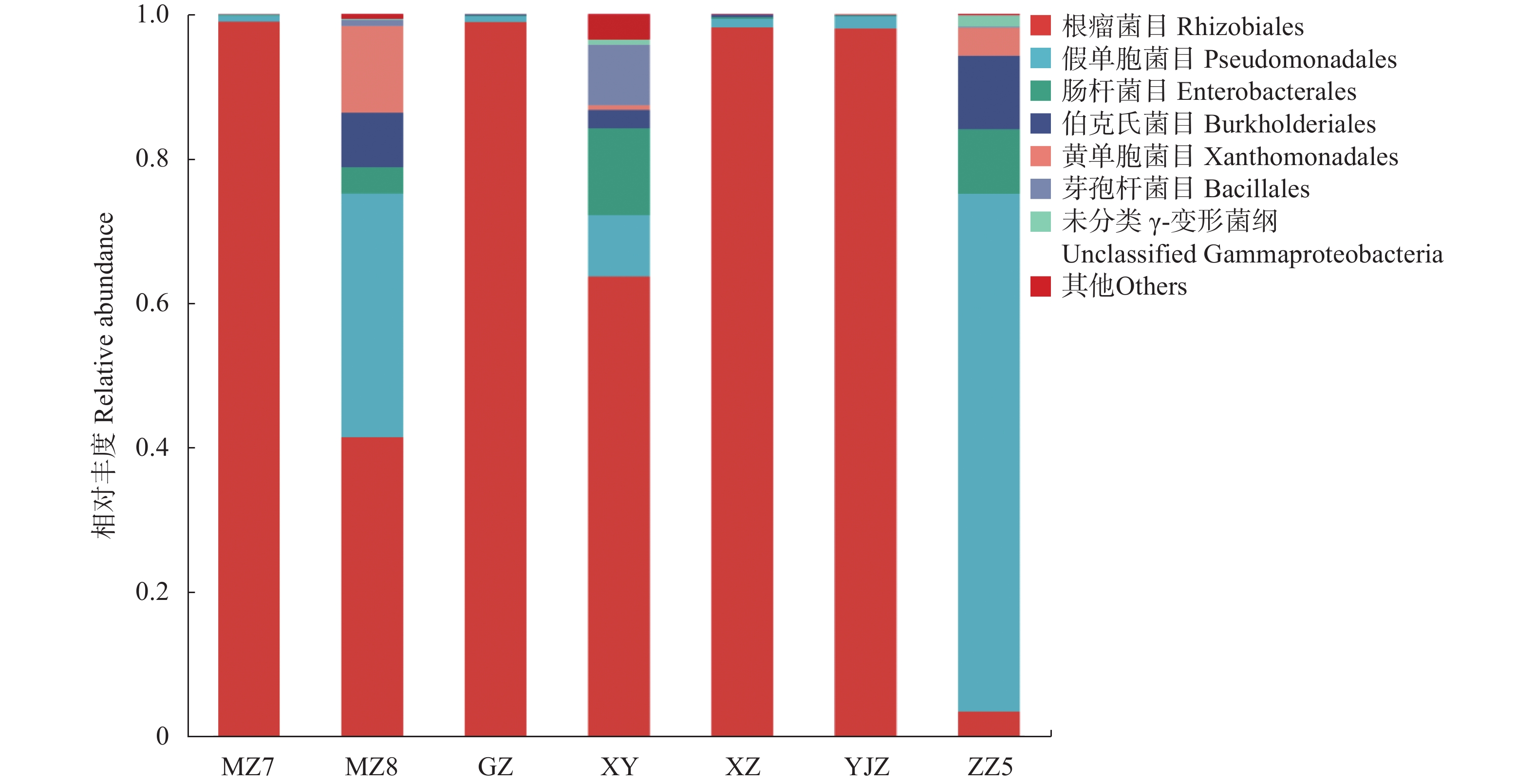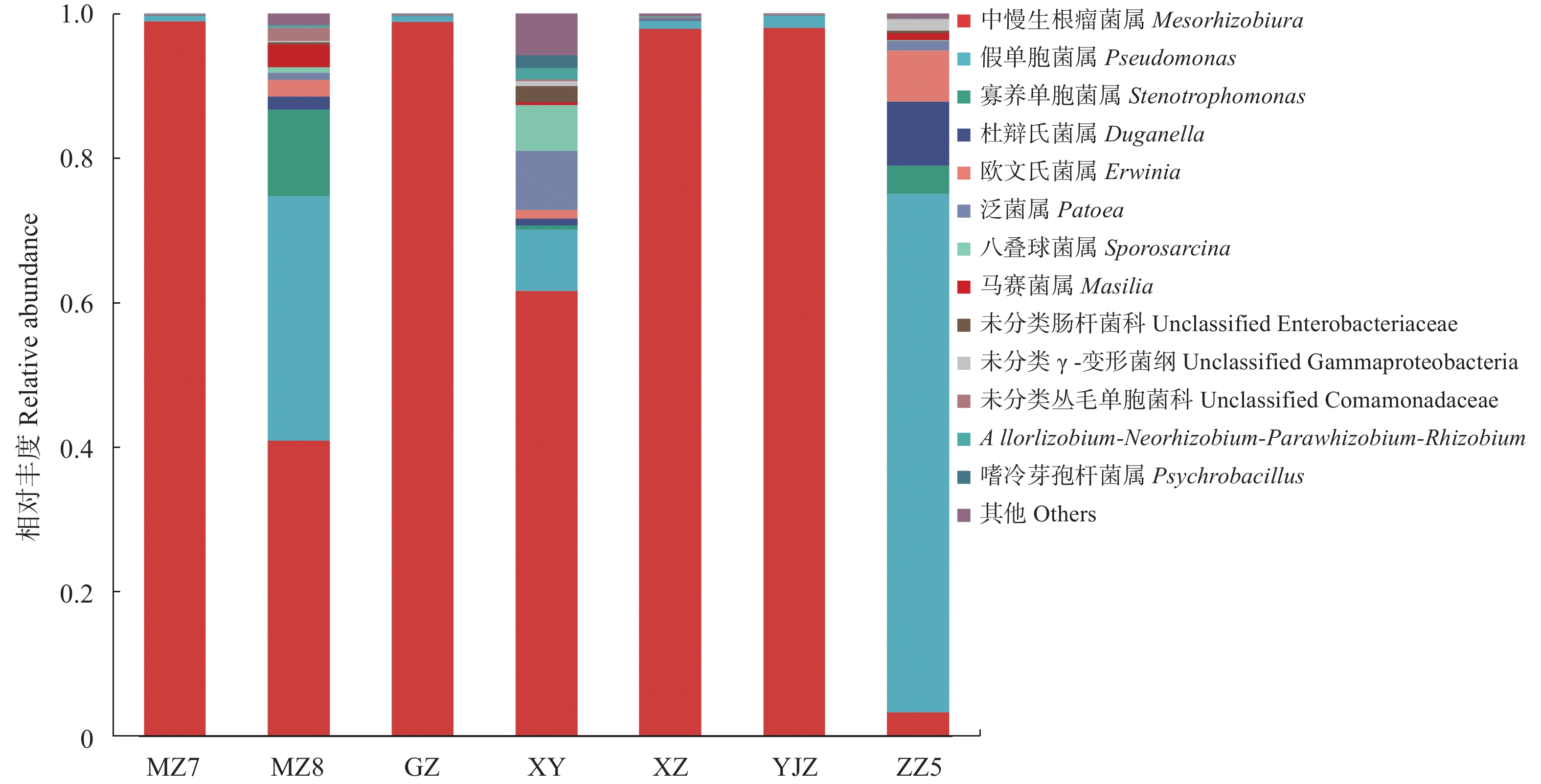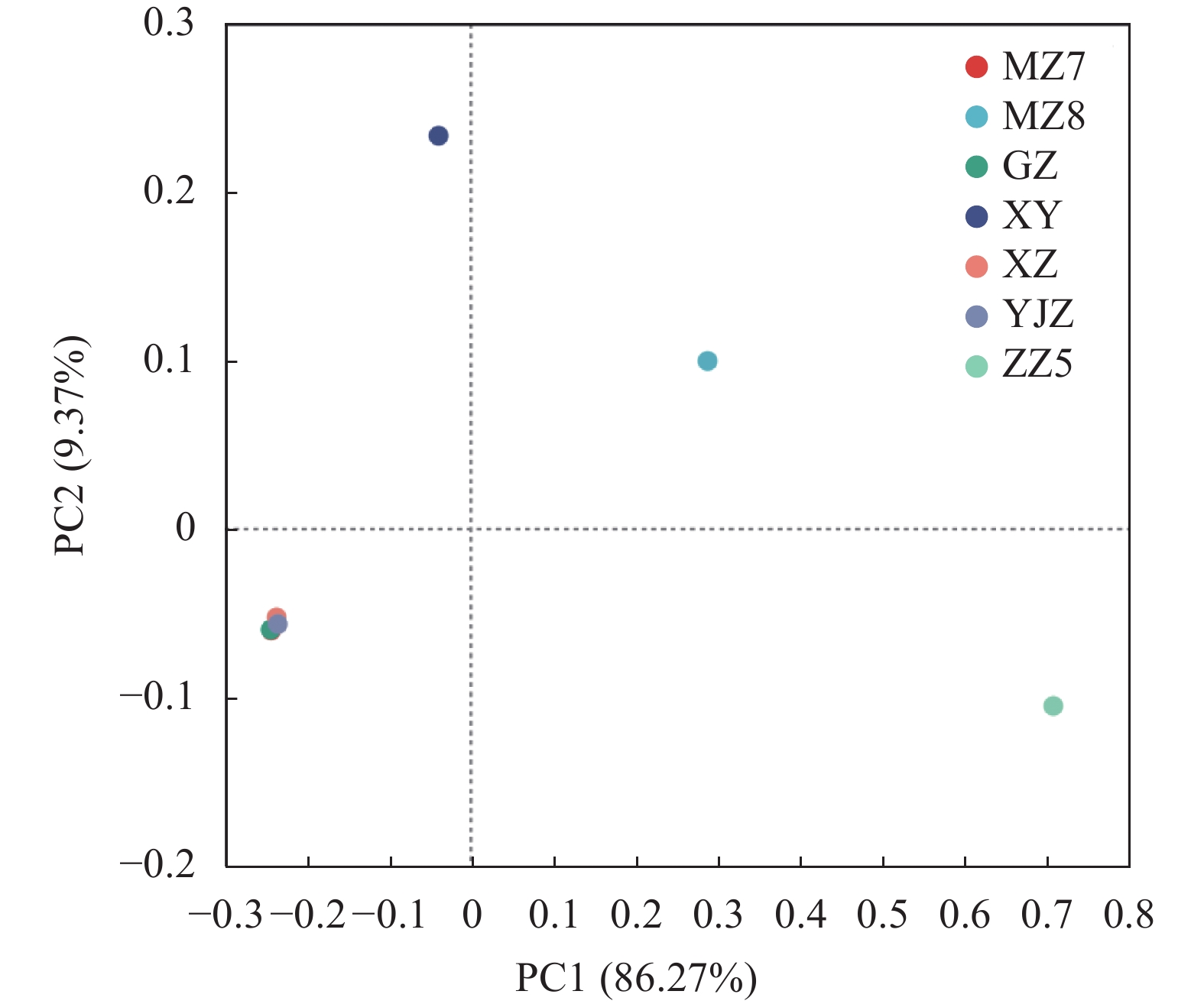Diversity of Endophytic Bacteria in Root Nodules of Different Cultivars of Astragalus Sinicus L
-
摘要:
目的 阐释紫云英根瘤内生菌的群落结构,为研发根瘤菌菌剂及了解固氮机制提供依据。 方法 以福建省种植的不同紫云英品种的根瘤为材料,借助Illumina Miseq PE300测序平台,以16S rRNA基因为靶标,研究不同紫云英品种的根瘤内生细菌的多样性。 结果 不同品种会影响紫云英根瘤内生细菌的类群和多样性。浙紫5号(ZZ5)的优势属为假单胞菌属Pseudomonas,其余品种根瘤内生细菌的优势属均为中慢生根瘤菌属Mesorhizobium。闽紫8号(MZ8)、信阳(XY)和浙紫5号的根瘤内生细菌的多样性指数(Shannon)较高,除了共生固氮的中慢生根瘤菌外,还包括丰富的非根瘤菌,如假单胞菌属、寡养单胞菌属Stenotrophomonas、杜擀氏菌属Duganella、泛菌属Pantoea、欧文氏菌属Erwinia等。闽紫8号、信阳和浙紫5号这3个品种根瘤中含有较高丰度的致病菌大黄欧文氏菌Erwinia rhapontici和菠萝泛菌PA13 Pantoea ananatis PA13。 结论 紫云英品种对根瘤内生细菌的群落结构有一定影响,浙紫5号的根瘤内生细菌主要为具促生作用的非根瘤菌假单胞菌,而其余品种为具固氮能力的根瘤菌,在生产实际中可以采用紫云英混种的方式达到固氮促生的双重功效。 Abstract: : [ Objective ] Analyzing the community structure of endophytic bacteria in root nodules is important to develop the rhizobium inoculants and understand the mechanism of fixing nitrogen. [ Method ] This study was conducted to investigate the diversity of endophytic bacteria in root nodules of A. sinicus. Seven cultivars of A. sinicus planted in Fujian province were selected to analyze the diversity of endophytic bacteria in root nodules using 16S rRNA gene as the target gene with Illumina Miseq PE300 sequencing platform. [ Result ] C ultivar could impact the composition of nodule endophytic bacteria. The most abundant genus in ZZ5 root nodule was Pseudomonas but the predominnat genus was Mesorhizobiumin in other cultivars. Furthermore, we found high Shannon indices of endophytic bacterial communities in the root nodules of MZ8, XY and ZZ5. These cultivars had a large diversity of non-rhizobial endophytes like Pseudomonas, Stenotrophomonas, Duganella and Erwinia, etc. The higher relative abundances of pathogen Erwinia rhapontici and Pantoea ananatis PA13 were observed in the root nodules of MZ8, XY and ZZ5. [ Conclusions ] The predominant endophytic bacteria of cultivar ZZ5 is non-rhizobial microorganism Pesudomonas which had the growth-promoting effect, while rhizobia are the predominant microorganism in other cultivars. Different cultivars can be applied in combination to get more effect.-
Key words:
- Astragalus sinicus /
- cultivar /
- root nodule /
- endophytic bacteria /
- diversity
-
图 1 门水平不同紫云英品种根瘤内生细菌的相对丰度
MZ7:闽紫7号、MZ8:闽紫8号、GZ:光泽、XY:信阳、XZ:湘紫、YJZ:弋江籽、ZZ5:浙紫5号,下同。
Figure 1. Relative abundance of endophytic bacteria in root nodules of different cultivars of A. sinicus on phylum level
MZ7: Minzi No. 7, MZ8: Minzi No.8, GZ: Guangze; XY: Xinyang, XZ: Xiangzi, YJZ: Yijiangzi, ZZ5: Zhezi No. 5, the same below.
表 1 不同紫云英品种根瘤内生细菌的Alpha多样性指数
Table 1. Alpha diversity index of endophytic bacteria in root nodules of different cultivars of A. sinicus on genus level
样本
SampleAce指数
Ace indexChao1 指数
Chao1 indexShannon指数
Shannon indexSimpson指数
Simpson index覆盖度
Coverage/%闽紫7号(MZ7)
Minzi No. 7 (MZ7)26.26 24.25 0.07 0.98 99.98 闽紫7号(MZ8)
Minzi No.8 (MZ8)104.42 90.11 1.58 0.30 99.93 光泽(GZ)
Guangze (GZ)25.86 23.67 0.08 0.98 99.98 信阳(XY)
Xinyang (XY)191.81 191.50 1.73 0.40 99.92 湘紫(XZ)
Xiangzi (XZ)97.85 68.60 0.14 0.96 99.94 弋江紫(YJZ)
Yijiangzi (YJZ)23.60 23.00 0.11 0.96 99.98 浙紫5号(ZZ5)
Zhezi No.5 (ZZ5)72.45 84.50 1.13 0.53 99.95 -
[1] 曹卫东, 黄鸿翔. 关于我国恢复和发展绿肥若干问题的思考 [J]. 中国土壤与肥料, 2009, (4):1−3. doi: 10.3969/j.issn.1673-6257.2009.04.001CAO W D, HUANG H X. Ideas on restoration and development of green manures in China [J]. Soil and Fertilizer Sciences in China, 2009(4): 1−3. (in Chinese) doi: 10.3969/j.issn.1673-6257.2009.04.001 [2] 谢志坚, 周春火, 贺亚琴, 等. 21世纪我国稻区种植紫云英的研究现状及展望[J]. 草业学报, 2018, 27(8): 185-196.XIE Z J, ZHOU C H, HE Y Q, et al. A review of Astragalus sinicus in paddy fields in South China since 2000s[J]. Acta Prataculturae Sinica, 2018, 27(8): 185-196. (in Chinese) [3] BREWIN N J. Development of the legume root nodule[J]. Annual Review of Cell Biology, 1991, 7: 191-226. [4] MARTÍNEZ-HIDALGO P, HIRSCH A M. The nodule microbiome: N2-fixing rhizobia do not live alone [J]. Phytobiomes Journal, 2017, 1(2): 70−82. doi: 10.1094/PBIOMES-12-16-0019-RVW [5] PREYANGA R, ANANDHAM R, KRISHNAMOORTHY R, et al. Groundnut (Arachis hypogaea) nodule Rhizobium and passenger endophytic bacterial cultivable diversity and their impact on plant growth promotion[J]. Rhizosphere, 2021, 17: 100309. [6] WILSON D. Endophyte: The evolution of a term, and clarification of its use and definition [J]. Oikos, 1995, 73(2): 274. doi: 10.2307/3545919 [7] MIRANDA-SÁNCHEZ F, RIVERA J, VINUESA P. Diversity patterns of Rhizobiaceae communities inhabiting soils, root surfaces and nodules reveal a strong selection of rhizobial partners by legumes [J]. Environmental Microbiology, 2016, 18(8): 2375−2391. doi: 10.1111/1462-2920.13061 [8] 张爱梅, 殷一然, 孔维宝, 等. 基于高通量测序分析西藏沙棘根瘤内生菌的多样性 [J]. 生态学报, 2021, 41(20):8212−8221.ZHANG A M, YIN Y R, KONG W B, et al. Diversity of endophytes associated with Hippophae tibetana root nodules based on high-throughput sequencing [J]. Acta Ecologica Sinica, 2021, 41(20): 8212−8221. (in Chinese) [9] 魏继华, 李佳益, 刘宏, 等. 沙棘根瘤内生菌株库构建与微生物多样性分析 [J]. 浙江农林大学学报, 2022, 39(2):356−363. doi: 10.11833/j.issn.2095-0756.20210246WEI J H, LI J Y, LIU H, et al. Construction of endophytic strain bank of seabuckthorn nodule and an analysis of microbial diversity [J]. Journal of Zhejiang A & F University, 2022, 39(2): 356−363. (in Chinese) doi: 10.11833/j.issn.2095-0756.20210246 [10] 肖潇. 豆科植物根际和根瘤内生细菌群落结构、变化规律及其影响因素研究[D]. 杨凌: 西北农林科技大学, 2017.XIAO X. The structure, variation and influence factors of leguminous plant rhizosphere and nodule endosphere microbiome[D]. Yangling: Northwest A & F University, 2017. (in Chinese) [11] 李静. 陕北地区白刺花根瘤内生菌遗传多样性及其促生特性研究[D]. 延安: 延安大学, 2022.LI J. Genetic diversity and growth promoting characteristics of endophytic bacteria from Sophora davidii (franch. ) skeels root nodules in northern shaanxi[D]. Yan’an: Yan’an University, 2022. (in Chinese) [12] BULGARELLI D, ROTT M, SCHLAEPPI K, et al. Revealing structure and assembly cues for Arabidopsis root-inhabiting bacterial microbiota [J]. Nature, 2012, 488(7409): 91−95. doi: 10.1038/nature11336 [13] LUNDBERG D S, LEBEIS S L, PAREDES S H, et al. Defining the core Arabidopsis thaliana root microbiome [J]. Nature, 2012, 488(7409): 86−90. doi: 10.1038/nature11237 [14] BULGARELLI D, GARRIDO-OTER R, MÜNCH P C, et al. Structure and function of the bacterial root microbiota in wild and domesticated barley [J]. Cell Host & Microbe, 2015, 17(3): 392−403. [15] CHEN S F, ZHOU Y Q, CHEN Y R, et al. Fastp: An ultra-fast all-in-one FASTQ preprocessor[J]. Bioinformatics, 2018, 34(17): i884-i890. [16] MAGOČ T, SALZBERG S L. FLASH: Fast length adjustment of short reads to improve genome assemblies[J]. Bioinformatics, 2011, 27(21): 2957-2963. [17] EDGAR R C. UPARSE: Highly accurate OTU sequences from microbial amplicon reads[J]. Nature Methods, 2013, 10: 996-998. [18] COLE J R, WANG Q, FISH J A, et al. Ribosomal Database Project: Data and tools for high throughput rRNA analysis[J]. Nucleic Acids Research, 2014, 42(Database issue): D633-D642. [19] 曹卫东, 高嵩涓. 到2025年中国绿肥发展策略 [J]. 中国农业资源与区划, 2023, 44(12):1−9.CAO W D, GAO S J. Chinese green manure development strategy by 2025 [J]. Chinese Journal of Agricultural Resources and Regional Planning, 2023, 44(12): 1−9. (in Chinese) [20] RAHIMLOU S, BAHRAM M, TEDERSOO L. Phylogenomics reveals the evolution of root nodulating alpha- and beta-Proteobacteria (rhizobia)[J]. Microbiological Research, 2021, 250: 126788. [21] PANG J F, PALMER M, SUN H J, et al. Diversity of root nodule-associated bacteria of diverse legumes along an elevation gradient in the Kunlun Mountains, China[J]. Frontiers in Microbiology, 2021, 12: 633141. [22] ZHANG J J, SHANG Y M, LIU C Z, et al. Mesorhizobium jarvisii is a dominant and widespread species symbiotically efficient on Astragalus sinicus L. in the Southwest of China[J]. Systematic and Applied Microbiology, 2020, 43(5): 126102. [23] 尚益民. 我国豆科绿肥共生根瘤菌多样性分析与优势菌种资源挖掘[D]. 郑州: 郑州轻工业大学, 2020SHANG Y M. The diversity analysis of legume green manure symbiotic rhizobia and mining of dominant species resources in china[D]. Zhengzhou: Zhengzhou University of Light Industry, 2020. (in Chinese) [24] TAPIA-GARCÍA E Y, HERNÁNDEZ-TREJO V, GUEVARA-LUNA J, et al. Plant growth-promoting bacteria isolated from wild legume nodules and nodules of Phaseolus vulgaris L. trap plants in central and southern Mexico[J]. Microbiological Research, 2020, 239: 126522. [25] SANTOYO G, DEL CARMEN OROZCO-MOSQUEDA M, GOVINDAPPA M. Mechanisms of biocontrol and plant growth-promoting activity in soil bacterial species ofBacillusandPseudomonas: A review[J]. Biocontrol Science and Technology, 2012, 22(8): 855-872. [26] BIESSY A, FILION M. Phenazines in plant-beneficial Pseudomonas spp. : Biosynthesis, regulation, function and genomics[J]. Environmental Microbiology, 2018, 20(11): 3905-3917. [27] 张学贤, 李阜棣, 曹燕珍, 等. 紫云英根瘤菌分子遗传学研究进展 [J]. 华中农业大学学报, 2003, 22(1):77−83. doi: 10.3321/j.issn:1000-2421.2003.01.018ZHANG X X, LI F D, CAO Y Z, et al. Molecular genetics of Astragalus sincus rhizobia [J]. Journal of Huazhong Agricultural, 2003, 22(1): 77−83. (in Chinese) doi: 10.3321/j.issn:1000-2421.2003.01.018 [28] 张俊杰, 彭姗姗, 尚益民, 等. 湖南益阳地区紫云英根瘤菌的遗传多样性研究 [J]. 河南农业大学学报, 2020, 54(3):480−487.ZHANG J J, PENG S S, SHANG Y M, et al. Study on genetic diversity of rhizobia associated with Astragalus sinicus L. from Yiyang, Hunan Province [J]. Journal of Henan Agricultural University, 2020, 54(3): 480−487. (in Chinese) [29] HUANG H C, HSIEH T F, ERICKSON R S. Biology and epidemiology of Erwinia rhapontici, causal agent of pink seed and crown rot of plants [J]. Plant Pathology Bulletin, 2003, 12: 69−76. [30] COTHER E J, NOBLE D H, VAN DE VEN R J, et al. Bacterial pathogens of rice in the Kingdom of Cambodia and description of a new pathogen causing a serious sheath rot disease[J]. Plant Pathology, 2010, 59(5): 944-953. -








 下载:
下载:





